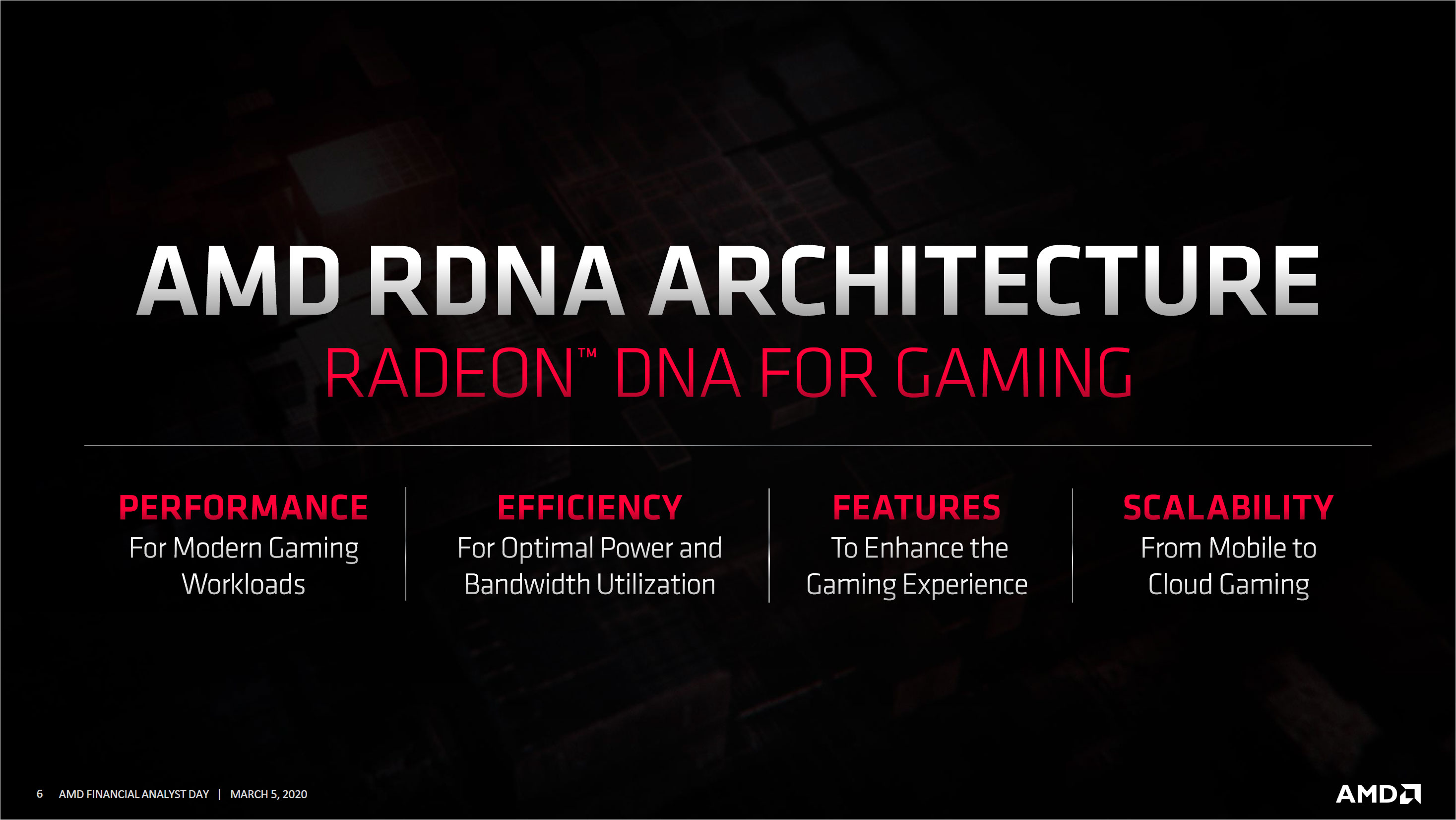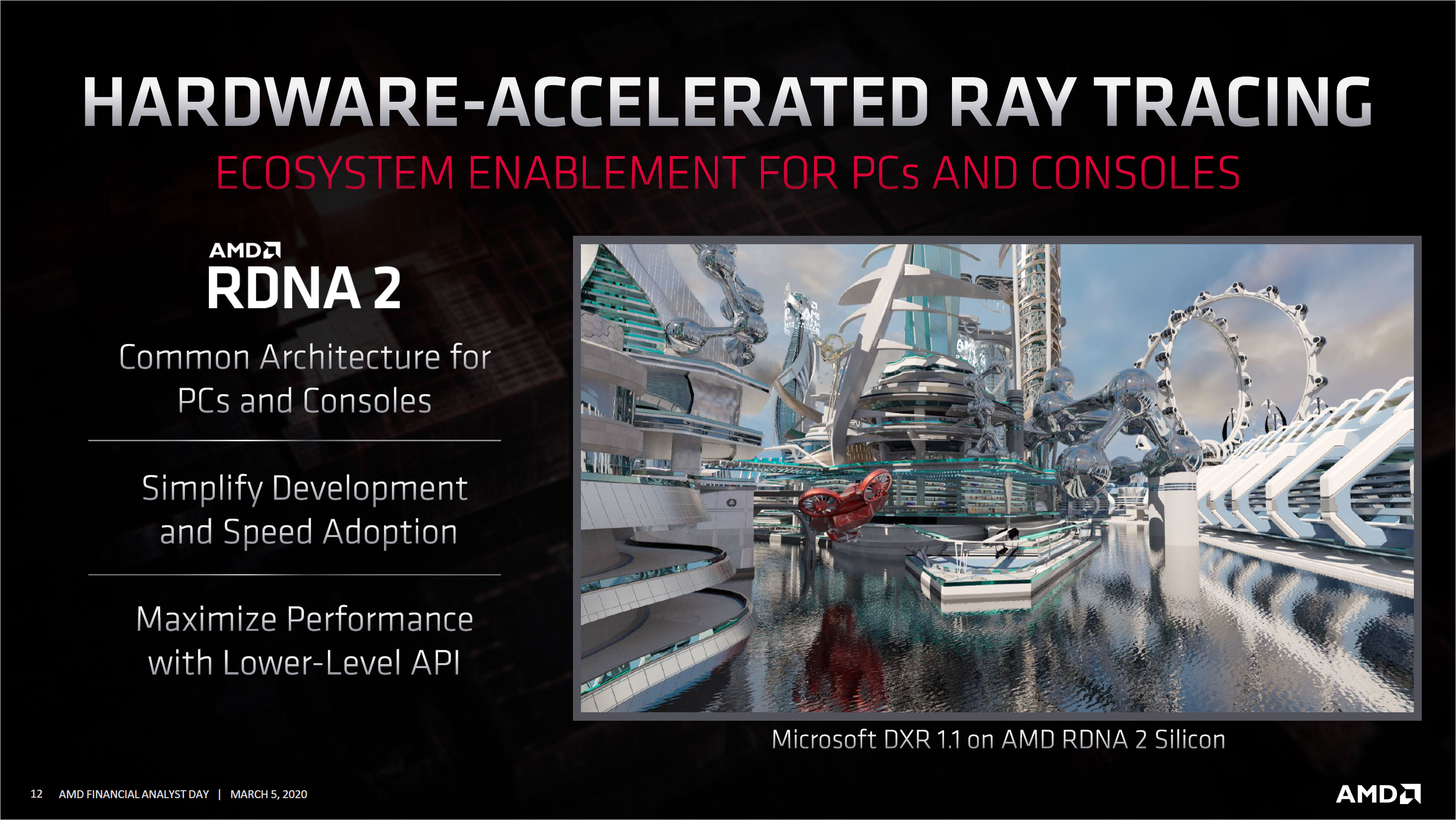AMD Says its Upcoming RDNA 2 and Navi 2x Will Boost Performance per Watt by 50%
Building on the RDNA architecture, AMD looks to tackle 4K and ray tracing with its next GPUs.
AMD has been gaining ground in the GPU market over the past year, with 7nm Navi 1x parts launching at the high-end, mainstream, and budget markets. During its Financial Analysts Day 2020, AMD is finally starting to spill the beans for what comes next. It's not called "Big Navi"—at least not officially—but while it will use a new RDNA 2 architecture for the Navi 2x GPUs, the foundation appears to be largely the same as existing Navi 1x / RDNA parts. These new RDNA 2 GPUs will power both next generation consoles from Sony and Microsoft, and more importantly, we're getting new GPUs for the PC as well.
What isn't clear is what market segments precisely will get Navi 2x, and when they'll get it. Certainly there will be an extreme gaming GPU, as AMD discussed going after 4K gaming. Considering the budget and mainstream RX 5500 XT and RX 5600 XT just arrived, however, it's unlikely we'll see them replaced at the end of the year. That is when the new consumer graphics cards are slated to arrive, incidentally—"by the end of this year." That leaves a bit of wiggle room for AMD to potentially launch them sooner, but we expect the new cards to arrive in the fall rather than the spring or summer.
Besides the architecture name and explicit launch date of this year, which we've already heard before, details remain thin. Navi 2x / RDNA 2 will bring ray tracing support, variable rate shading support, and the always-nebulous "more." AMD also mentioned performance per Watt improvements, however, which is new. The only hard data AMD provided is that just as RDNA 1 brought a 50% improvement in performance per Watt compared to the previous GCN architecture, RDNA 2 is supposed to bring a 50% improvement in performance per Watt compared to RDNA 1.





What does that mean, exactly? That's where things get very murky. If AMD includes ray tracing performance in any fashion, it should be trivial to achieve a 50% improvement in performance per Watt. Assuming it's more than that, however, and either AMD is looking to provide 50% more performance than current RDNA 1 parts at the same power levels, or else cut power requirements by 33% while keeping performance the same, or most likely RDNA 2 will land somewhere in between those two.
Still, 50% percent performance per watt does give us the potential for a significant jump in AMD graphics performance relative to the RX 5700 XT. Let's also discuss what that might mean. By our own benchmarks, the RTX 2080 Ti is currently the fastest consumer graphics card, beating the RX 5700 XT by about 31% on average. That's not the whole story, however. The RTX 2080 Ti is only 15% faster than the 5700 XT at 1080p medium, 25% faster at 1080p ultra, 40% faster at 1440p ultra, and 50% faster at 4K ultra. The problem is that the RTX 2080 Ti will be two years old this fall, and Nvidia is expected to launch its next-generation Ampere GPUs this year as well.
Without additional details on the hardware, it's too early to draw any conclusions. AMD did show a video of hardware ray tracing that was rendered using its RDNA 2 silicon, but it was not a live demo—the content was previously rendered. We'd love to see improved ray tracing performance compared to Nvidia's RTX 20-series, but even more critical, we'd love to see games doing things with ray tracing that make it into a "must have" feature. We're definitely not there yet.
RDNA 2 will be a common architecture for PCs and next-gen consoles, and AMD notes DirectX Raytracing (DXR) 1.1 capabilities. Unfortunately, that's about the extent of what AMD is saying on the consumer graphics side. Core counts, clock speeds, real-world performance, pricing and 'more' will be revealed later this year. Hopefully Navi 2x parts will prove competitive when they arrive.
Get Tom's Hardware's best news and in-depth reviews, straight to your inbox.
Besides RDNA 2 and Navi 2x, AMD also mentioned RDNA 3 and Navi 3x. Not surprisingly, things are incredibly thin here. AMD showed a slide with a tentative launch date of some time before the end of 2022, and other than the RDNA 3 and Navi 3x there's nothing to say. Given RDNA launched in mid-2019 and RDNA 2 is coming at the end of 2020, AMD is running on a 1.5 year cadence of new architectures. That means RDNA 4 and Navi 4x are coming by 2024—you heard it first here, folks!

Jarred Walton is a senior editor at Tom's Hardware focusing on everything GPU. He has been working as a tech journalist since 2004, writing for AnandTech, Maximum PC, and PC Gamer. From the first S3 Virge '3D decelerators' to today's GPUs, Jarred keeps up with all the latest graphics trends and is the one to ask about game performance.
-
Giroro "by the end of this year."Reply
He was stumbling on his words a bit, he also said they would be announced late this year. -
willgart my problem: if they reduces the watt by 50%... there is no performance improvement at all at the end.Reply
so the perf per watt is fine for data centers.
but for gamers... we dont care.
so give me a 300watt GPU (33% more than the 5700XT) + 50%/watt = 19.5TFlops -
JarredWaltonGPU Reply
I suspect it will be a 250W level that’s 20-30% faster than the 5700 XT. But a lot of that might be in specific workloads. I’m certainly curious to see actual specs though.willgart said:my problem: if they reduces the watt by 50%... there is no performance improvement at all at the end.
so the perf per watt is fine for data centers.
but for gamers... we dont care.
so give me a 300watt GPU (33% more than the 5700XT) + 50%/watt = 19.5TFlops -
escksu Performance per watt is very ambiguous...... But its extremely unlikely we will see a GPU that has same performance as 5700XT but consumes 1/3 less power.....5700XT is 225W is 1/3 less is 150W. Neither will we see a new 225W GPU thats 50% faster.Reply
I think its probably somewhere in between. AMD and Nvidia loves to make GPUs that pretty comparable so as not to upset the market.
I am inclined to believe we will see 175W-200W GPU. Then we get around 20% higher in performance. So I think we will see 2080 Super or maybe 2080ti performance for 175-200W GPU. Maybe it will be called 6700xt. -
Deicidium369 AMD always shooting for last year's Nvidia product and still coming up short. The full-screen ray tracing on consoles will be CLOUD-BASED... I hope your internet connection is fast, low latency and without caps.Reply
I hope they come out with something that can actually compete with Nvidia at the high end - but that is highly unlikely. I haven't seen anything to rival my dual 2080Ti cards - and the next upgrade will be dual Ampere "3080Ti".
Maybe AMD could start making outdoor furniture to make some money, it seems like they are not selling much of anything - yeah those exascale supercomputers are great - but they are a 1 shot and done thing - and the #s they sell is a rounding error at Intel. -
Deicidium369 Replyescksu said:Performance per watt is very ambiguous...... But its extremely unlikely we will see a GPU that has same performance as 5700XT but consumes 1/3 less power.....5700XT is 225W is 1/3 less is 150W. Neither will we see a new 225W GPU thats 50% faster.
I think its probably somewhere in between. AMD and Nvidia loves to make GPUs that pretty comparable so as not to upset the market.
I am inclined to believe we will see 175W-200W GPU. Then we get around 20% higher in performance. So I think we will see 2080 Super or maybe 2080ti performance for 175-200W GPU. Maybe it will be called 6700xt.
Lets not get crazy with the optimism - 2080 maybe - super and Ti probably not. I really don't care whether a card pulls 10W or 500W - if it is the top performer at the high end - then it doesn't matter. IF you are that concerned about your electric bill then the high end is not for you.
6700XT is likely - 2080 levels at around the same 200-250W envelope - but that great and all in a world without Nvidia releasing a major update (architecturally and process) sometimes this year as well. AMD needs to invest in someone with experience in drivers to shore up the terrible video drivers. Greatest hardware in the universe with a total crap software environment is nothing. -
Deicidium369 Reply
And that "19.5TFLOPs" without good drivers might as well not even exist - both sides have to be upto the task - best HW in the world is meaningless without SW that can unlock that performance.willgart said:my problem: if they reduces the watt by 50%... there is no performance improvement at all at the end.
so the perf per watt is fine for data centers.
but for gamers... we dont care.
so give me a 300watt GPU (33% more than the 5700XT) + 50%/watt = 19.5TFlops -
King_V Replywillgart said:my problem: if they reduces the watt by 50%... there is no performance improvement at all at the end.
That's not how the math works.
50% more performance per watt would mean either:
- Same wattage, but 150% (ie: 3/2) of the performance of an existing Navi
OR
- Same performance, but 66% (ie: 2/3) of the power draw of an existing Navi. Basically, getting 150% of your "performance units" (whatever they may be) per watt of consumption.
As to the details, well, obviously we can't know now. -
JarredWaltonGPU Reply
RTX 2080 Super seems highly plausible, considering the 2080 Super is only 15-25 percent faster than RX 5700 XT (24% faster at 4K ultra to be precise, and 14% faster at 1080p ultra). I'm still curious how AMD expects to do 50% better perf per watt than Navi 1x with Navi 2x unless there are actually significant architectural updates. 25% better performance by adding more cores? That's totally feasible. But doing 25% more performance than RX 5700 XT and only using 188W is surprising with the same 7nm node. I hope AMD is serious about this result, but I'm very skeptical of it getting there in general and not just in select scenarios.Deicidium369 said:Lets not get crazy with the optimism - 2080 maybe - super and Ti probably not. I really don't care whether a card pulls 10W or 500W - if it is the top performer at the high end - then it doesn't matter. IF you are that concerned about your electric bill then the high end is not for you.
6700XT is likely - 2080 levels at around the same 200-250W envelope - but that great and all in a world without Nvidia releasing a major update (architecturally and process) sometimes this year as well. AMD needs to invest in someone with experience in drivers to shore up the terrible video drivers. Greatest hardware in the universe with a total crap software environment is nothing. -
Gurg ReplyDeicidium369 said:AMD always shooting for last year's Nvidia product and still coming up short.
AMD still can't match the performance of the three year old 1080ti. Nothing in the presentation said anything about gaming performance, just performance per watt. efficiency. How long will it take for AMD to work the bugs out of the software to seamlessly run two of its slow GPUs stuck together?